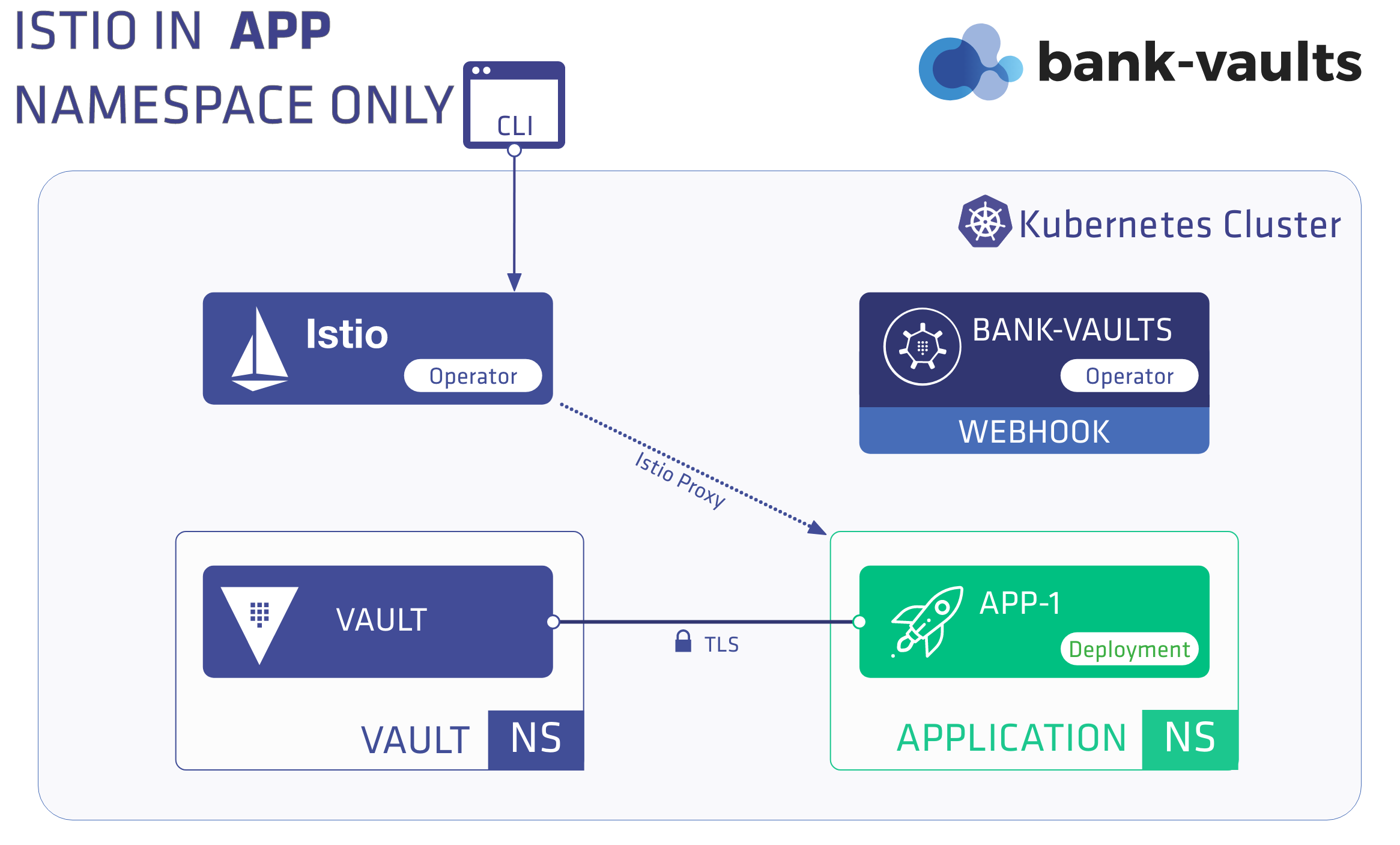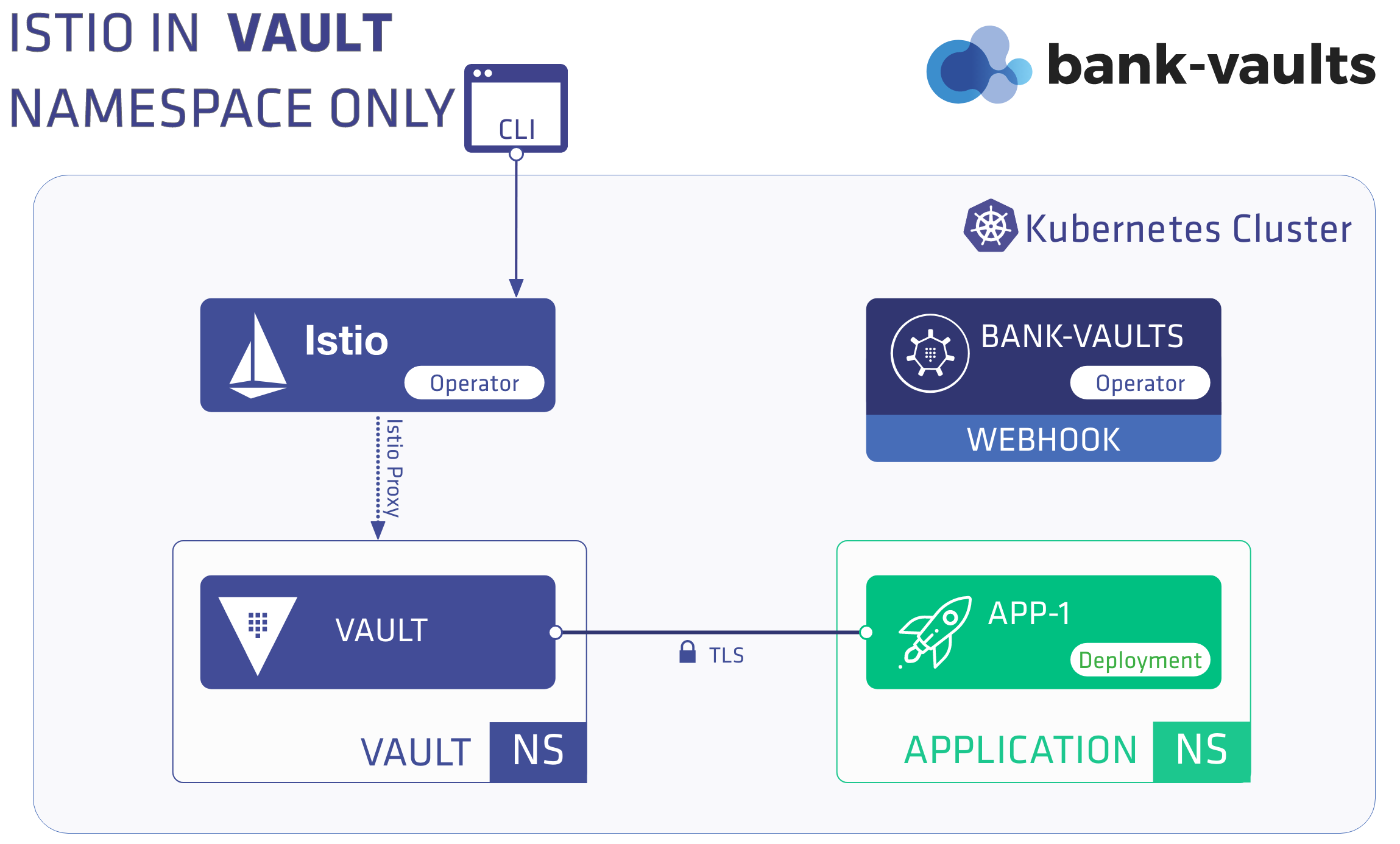This is the multi-page printable view of this section.
Click here to print.
Return to the regular view of this page.
Running the Bank-Vaults secret webhook alongside Istio
Both the vault-operator and the vault-secrets-webhook can work on Istio-enabled clusters.
We support the following three scenarios:
Prerequisites
-
Install the Istio operator.
-
Make sure you have mTLS enabled in the Istio mesh through the operator with the following command:
Enable mTLS if it is not set to STRICT:
kubectl patch istio -n istio-system mesh --type=json -p='[{"op": "replace", "path": "/spec/meshPolicy/mtlsMode", "value":STRICT}]'
-
Check that mesh is configured with mTLS turned on which applies to all applications in the cluster in Istio-enabled namespaces. You can change this if you would like to use another policy.
kubectl get meshpolicy default -o yaml
Expected output:
apiVersion: authentication.istio.io/v1alpha1
kind: MeshPolicy
metadata:
name: default
labels:
app: security
spec:
peers:
- mtls: {}
Now your cluster is properly running on Istio with mTLS enabled globally.
Install the Bank-Vaults components
-
You are recommended to create a separate namespace for Bank-Vaults called vault-system. You can enable Istio sidecar injection here as well, but Kubernetes won’t be able to call back the webhook properly since mTLS is enabled (and Kubernetes is outside of the Istio mesh). To overcome this, apply a PERMISSIVE Istio authentication policy to the vault-secrets-webhook Service itself, so Kubernetes can call it back without Istio mutual TLS authentication.
kubectl create namespace vault-system
kubectl label namespace vault-system name=vault-system istio-injection=enabled
kubectl apply -f - <<EOF
apiVersion: authentication.istio.io/v1alpha1
kind: Policy
metadata:
name: vault-secrets-webhook
namespace: vault-system
labels:
app: security
spec:
targets:
- name: vault-secrets-webhook
peers:
- mtls:
mode: PERMISSIVE
EOF
-
Now you can install the operator and the webhook to the prepared namespace:
helm upgrade --install --wait vault-secrets-webhook oci://ghcr.io/bank-vaults/helm-charts/vault-secrets-webhook --namespace vault-system --create-namespace
helm upgrade --install --wait vault-operator oci://ghcr.io/bank-vaults/helm-charts/vault-operator --namespace vault-system
Soon the webhook and the operator become up and running. Check that the istio-proxy got injected into all Pods in vault-system.
Proceed to the description of your scenario:
1 - Scenario 1 - Vault runs outside, the application inside the mesh
In this scenario, Vault runs outside an Istio mesh, whereas the namespace where the application runs and the webhook injects secrets has Istio sidecar injection enabled.

First, complete the Prerequisites, then install Vault outside the mesh, and finally install an application within the mesh.
Install Vault outside the mesh
-
Provision a Vault instance with the Bank-Vaults operator in a separate namespace:
kubectl create namespace vault
-
Apply the RBAC and CR files to the cluster to create a Vault instance in the vault namespace with the operator:
kubectl apply -f rbac.yaml -f cr-istio.yaml
kubectl get pods -n vault
Expected output:
NAME READY STATUS RESTARTS AGE
vault-0 3/3 Running 0 22h
vault-configurer-6458cc4bf-6tpkz 1/1 Running 0 22h
If you are writing your own Vault CR make sure that istioEnabled: true is configured, this influences port naming so the Vault service port protocols are detected by Istio correctly.
-
The vault-secrets-webhook can’t inject Vault secrets into initContainers in an Istio-enabled namespace when the STRICT authentication policy is applied to the Vault service, because Istio needs a sidecar container to do mTLS properly, and in the phase when initContainers are running the Pod doesn’t have a sidecar yet.
If you wish to inject into initContainers as well, you need to apply a PERMISSIVE authentication policy in the vault namespace, since it has its own TLS certificate outside of Istio scope (so this is safe to do from networking security point of view).
kubectl apply -f - <<EOF
apiVersion: authentication.istio.io/v1alpha1
kind: Policy
metadata:
name: default
namespace: vault
labels:
app: security
spec:
peers:
- mtls:
mode: PERMISSIVE
EOF
Install the application inside a mesh
In this scenario Vault is running outside the Istio mesh (as we have installed it in the previous steps and our demo application runs within the Istio mesh. To install the demo application inside the mesh, complete the following steps:
-
Create a namespace first for the application and enable Istio sidecar injection:
kubectl create namespace app
kubectl label namespace app istio-injection=enabled
-
Install the application manifest to the cluster:
kubectl apply -f app.yaml
-
Check that the application is up and running. It should have two containers, the app itself and the istio-proxy:
Expected output:
NAME READY STATUS RESTARTS AGE
app-5df5686c4-sl6dz 2/2 Running 0 119s
kubectl logs -f -n app deployment/app app
Expected output:
time="2020-02-18T14:26:01Z" level=info msg="Received new Vault token"
time="2020-02-18T14:26:01Z" level=info msg="Initial Vault token arrived"
s3cr3t
going to sleep...
2 - Scenario 2 - Running Vault inside the mesh
To run Vault inside the mesh, complete the following steps.

Note: These instructions assume that you have Scenario 1 up and running, and modifying it to run Vault inside the mesh.
-
Turn off Istio in the app namespace by removing the istio-injection label:
kubectl label namespace app istio-injection-
kubectl label namespace vault istio-injection=enabled
-
Delete the Vault pods in the vault namespace, so they will get recreated with the istio-proxy sidecar:
kubectl delete pods --all -n vault
-
Check that they both come back with an extra container (4/4 and 2/2 now):
kubectl get pods -n vault
Expected output:
NAME READY STATUS RESTARTS AGE
vault-0 4/4 Running 0 1m
vault-configurer-6d9b98c856-l4flc 2/2 Running 0 1m
-
Delete the application pods in the app namespace, so they will get recreated without the istio-proxy sidecar:
kubectl delete pods --all -n app
The app pod got recreated with only the app container (1/1) and Vault access still works:
Expected output:
NAME READY STATUS RESTARTS AGE
app-5df5686c4-4n6r7 1/1 Running 0 71s
kubectl logs -f -n app deployment/app
Expected output:
time="2020-02-18T14:41:20Z" level=info msg="Received new Vault token"
time="2020-02-18T14:41:20Z" level=info msg="Initial Vault token arrived"
s3cr3t
going to sleep...
3 - Scenario 3 - Both Vault and the app are running inside the mesh
In this scenario, both Vault and the app are running inside the mesh.

-
Complete the Prerequisites.
-
Enable sidecar auto-injection for both namespaces:
kubectl label namespace app istio-injection=enabled
kubectl label namespace vault istio-injection=enabled
-
Delete all pods so they are getting injected with the proxy:
kubectl delete pods --all -n app
kubectl delete pods --all -n vault
-
Check the logs in the app container. It should sill show success:
kubectl logs -f -n app deployment/app
Expected output:
time="2020-02-18T15:04:03Z" level=info msg="Initial Vault token arrived"
time="2020-02-18T15:04:03Z" level=info msg="Renewed Vault Token"
s3cr3t
going to sleep...


